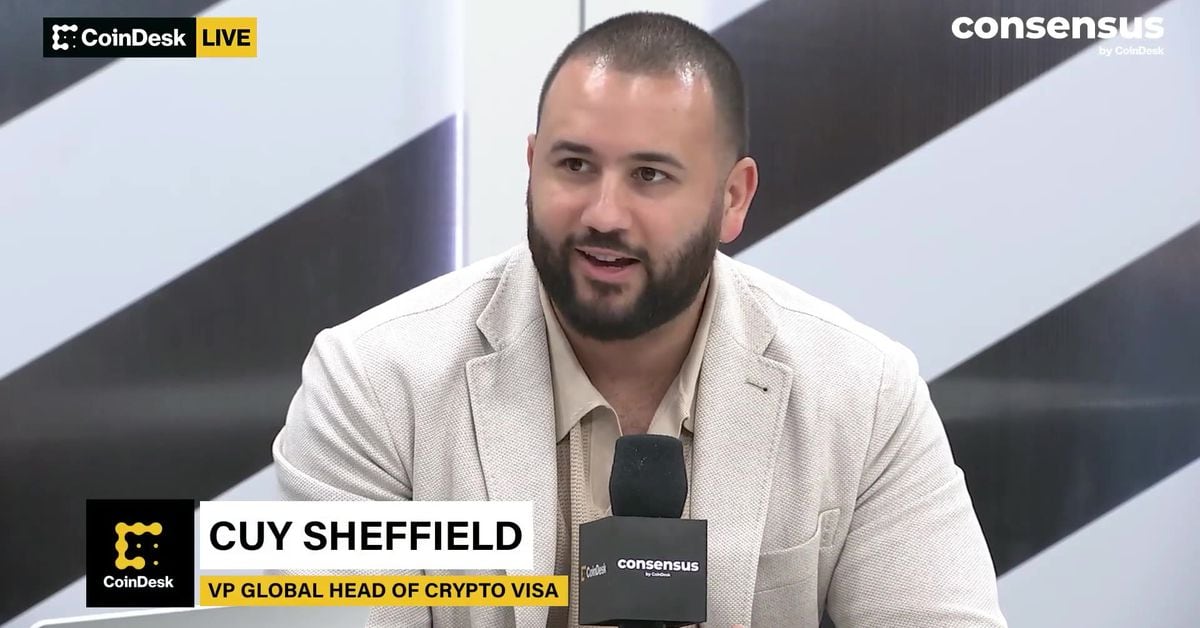Regulation
Visa est le « pont » entre les technologies de paiement et de blockchain : responsable de la cryptographie | Vidéo

Accueillons Kai Sheffield, responsable de Crypto chez Visa, au salon. Bienvenue, c’est formidable d’être ici. Merci de m’avoir. Merci d’être resté assis là pendant que nous faisions notre petit spectacle de marionnettes. C’est super. D’accord. Nous sommes donc au consensus 2024. Euh, parlez-nous de votre expérience jusqu’à présent. C’est le deuxième jour. Quelles ont été les vibrations pour vous ? C’est fantastique. Je pense qu’il y a beaucoup d’énergie et d’élan. Nous sommes vraiment impatients de voir ce que les développeurs construisent et, et vraiment, à quel point, vous savez, la technologie Blockchain a, vous savez, commencé à mûrir et comment l’infrastructure s’est améliorée et vous savez, de nombreux cas d’utilisation de paiement différents, vous savez, qui pensent que les pièces stables que vous connaissez peuvent aider à le rendre possible. C’est donc formidable de collaborer avec de nombreux clients, de nombreuses entreprises et partenaires de l’écosystème des paiements qui recherchent et explorent tous comment les technologies Blockchain peuvent être utilisées pour améliorer les flux de paiement. Aujourd’hui, Visa est l’une des sociétés les plus importantes en matière de paiements de toutes sortes dans le monde. Et vous êtes là depuis un certain temps en tant que responsable de la cryptographie, je me demande depuis quelques années, comment les conversations ont-elles changé depuis lors jusqu’à aujourd’hui en interne, comme les idées que vous défendez pour les projets que vous Je fais pression, comment cela a-t-il changé au fil du temps à l’intérieur d’un visa ? Nous avons donc fait des progrès très réguliers, vous savez, régulièrement chaque semaine depuis cinq ans maintenant. Et nous avons en fait mis en place l’équipe crypto au plus profond du marché baissier fin 2018, début 2019. Et donc notre approche adoptait vraiment une vision à long terme. Euh, cela veut dire si Visa se soucie de toute technologie susceptible d’améliorer les paiements. Nous voulions donc prendre notre temps, vous savez, pour trouver des moyens par lesquels nous pourrions, vous savez, utiliser ces technologies pour soutenir, vous savez, nos partenaires. Euh Et, vous savez, nous avons commencé, vous savez, à expérimenter des pièces stables. Nous avons commencé à faire beaucoup de recherches, beaucoup d’éducation, vous savez, pour nos clients. Euh, et notre objectif est simplement de continuer à faire des progrès cohérents et réguliers au cours de la prochaine décennie. Euh Et nous sommes vraiment enthousiasmés par les opportunités que les pièces particulièrement stables peuvent offrir pendant cinq ans aux haussiers et aux baissiers. C’était une jolie petite mise en place. On ne savait pas qu’on faisait là avec nos marionnettes euh en interne. Y a-t-il déjà eu des refus de la part de quelqu’un qui vous interrogeait sur le marché baissier ? Par exemple, devrions-nous consacrer ce temps et ces efforts à construire dans cette industrie qui semble assez volatile ? Nous avons eu vraiment la chance d’être dans une entreprise qui a une culture qui, vous savez, depuis le début, depuis les premiers jours de Visa et, vous savez, Dee Haw, vous vous savez, depuis les années soixante, vous savez, reconnaissez que la valeur va être numérisée. Cela va se déplacer sur de nombreux réseaux différents et nous voulons être le point de connexion unique pour les clients, vous savez, pour déplacer de la valeur dans de nombreux endroits différents dans de nombreux flux de paiement différents. Euh Et nous reconnaissons donc que, vous savez, les prix des actifs cryptographiques sont volatils. Nous ne nous soucions pas vraiment des prix, nous nous soucions de la technologie sous-jacente et de la manière dont elle peut être déployée au sein de l’écosystème des paiements, mais cela prend du temps et vous devez le faire dans un client contrôlé, vous savez. , de manière sûre. Euh Et donc nous sommes vraiment là pour le long terme et avons continué à faire des progrès constants, vous savez, malgré les cycles du marché actuels dans un récent article de recherche sur les visas, je crois que vous et vos collègues avez trouvé que le montant de plusieurs milliards de dollars était stable. marché des pièces de monnaie, seule une fraction de celui-ci est réellement utilisée par de vraies personnes dans le sens du paiement, je pense que 100 et 49 milliards ou un chiffre comme ça, ce qui est un chiffre important, mais c’est le cas, ce n’est pas représentatif d’une utilisation stable des pièces de monnaie. dans son ensemble. À votre avis, que faudra-t-il pour augmenter ce nombre et accroître l’adoption réelle des Stablecoins comme moyen de paiement approprié ? Tout d’abord, nous pensons que l’un des aspects uniques des Stablecoins est le fait que vous pouvez voir toutes les données, vous savez, sur la chaîne. Nous avons donc investi beaucoup de temps et de ressources dans la manière de comprendre les données de la chaîne et de comprendre comment les pièces stables sont utilisées. Euh Et donc nous travaillons en partenariat avec AM Labs, nous avons mis en place un visa de tableau de bord sur Chain Analytics.com. Et c’était vraiment cet exercice, vous savez, nous utilisons les données en chaîne en interne. Euh, vous savez, cela répond à certaines questions, cela ouvre beaucoup plus de questions et nous voulions le rendre disponible en tant qu’outil et ressource public gratuit pour nos clients, pour les décideurs politiques, pour les médias. Et vous savez, nous avons commencé avec ces transactions ajustées, vous savez, métriques, vous savez, en cherchant à filtrer les transactions qui semblent être initiées, vous savez, par des robots ou dans le cadre de contrats intelligents. Ce n’est pas parfait. Euh, donc nous ne disons pas que c’est la fin de tout. Mais nous pensons que l’industrie a de nombreuses opportunités d’utiliser réellement les données de la chaîne, vous savez, pour mieux comprendre comment les gens utilisent les pièces stables. Et ce que nous retenons, ce n’est pas que les consommateurs utilisent des pièces stables pour acheter leur café. Ses pièces stables sont utilisées pour des choses telles que les paiements B to B de grande valeur. Euh, transfrontalier, vous savez, peer to peer. Euh Et donc je pense que nous sommes juste au point où nous franchissons le gouffre des consommateurs qui sont déjà dans l’espace crypto, qui échangent des crypto sur un échange en utilisant des pièces stables, vous savez, payant d’autres personnes en crypto pour l’infrastructure étant là, elle peut permettre aux consommateurs traditionnels, en particulier en dehors des États-Unis dans les marchés émergents, vous savez, de se payer les uns les autres, euh pour payer les entreprises dans bon nombre de ces flux, vous savez, sur les rails Blockchain, mais il y a un long chemin à parcourir . Euh, vous savez, nous sommes ravis de découvrir comment nous pouvons nous associer avec des entreprises existantes dans l’écosystème des paiements pour commencer à intégrer des pièces stables de manière unique. Et nous pensons que ce doivent être les deux ensemble. Ce n’est pas un réseau de paiement traditionnel ou des pièces stables. Comment pourront-ils interagir les uns avec les autres pour améliorer les paiements ? Parlez-nous-en un peu plus. Quel est le rôle de Visa dans l’avenir des Stablecoins ? Ouais. Nous nous considérons donc comme un pont entre les pièces stables de la technologie Blockchain et l’écosystème de paiement existant. L’une des choses que nous avons fait a été d’investir dans la manière dont nous pouvons utiliser les Stablecoins dans certains de nos produits principaux. Vous savez, par exemple, lorsque vous payez avec une carte Visa, celle-ci est instantanément autorisée et vous pouvez sortir du magasin. Mais il y a beaucoup de choses qui doivent se produire pour que l’argent soit transféré de celui qui a émis cette carte, vous savez, vers, vous savez, la banque marchande de l’autre côté. Nous avons donc commencé à expérimenter des pièces stables comme nous, cc, fonctionnant sur des blockchains comme Solana pour offrir à nos clients la possibilité de régler avec nous, vous savez, via une Blockchain. Nous pouvons donc recevoir des pièces stables, vous savez, sur un compte que nous avons un cercle, nous pouvons ensuite les convertir, vous savez, pour les payer en fiat à un marchand et à une chorale. Et donc je pense que nous avons, vous savez, un réseau très diversifié d’institutions financières traditionnelles, de sociétés de technologie financière et de cryptographie. Nous essayons de comprendre comment le visa peut être un pont permettant à toutes ces entreprises d’adopter des pièces stables et des blockchains en même temps, rencontrons-les là où elles se trouvent. S’ils veulent utiliser des pièces stables, parfait, nous pourrions les soutenir. Ils opèrent en mode fiduciaire traditionnel. Nous gérerons les conversions, vous savez, à nouveau. Nous sommes donc impatients de voir comment nous pouvons jouer ce rôle de pont. Et cela me rappelle qu’avant les candidats, j’avais ma coupe de cheveux d’avant-conférence, comme nous le faisons tous. Euh, mon coiffeur ne prend que du cash. J’ai dit, oh, c’était juste une question de frais, car très souvent, les petites entreprises n’aiment pas les cartes de crédit à cause des frais. Il a dit non, ce n’est pas à cause des frais. C’est parce que le vendredi, si je suis payé par carte de crédit, je ne peux pas aller à la banque et récupérer mon argent parce que les banques sont fermées. Je me demande donc comment Visa envisage d’aider les petites entreprises à utiliser et à réaliser que les pièces stables pourraient permettre un règlement instantané et qu’elles pourraient accepter des paiements numériques. Euh, et ne vous inquiétez pas de choses comme la fermeture des banques le week-end. Ouais. Nous faisons donc beaucoup de choses au sein de l’entreprise pour essayer d’accélérer, vous savez, la rapidité avec laquelle nous pouvons obtenir de l’argent, en particulier pour les petites entreprises. Vous savez, nous avons un produit appelé Visa Direct qui vous permet d’effectuer des paiements et de créer une petite entreprise, d’obtenir de l’argent directement sur leur carte de débit le week-end. Nous ne pensons donc pas qu’il s’agisse uniquement de pièces stables. Nous pensons que les Stablecoins ont du potentiel et que, derrière les produits Visa existants, ils pourraient potentiellement déplacer de l’argent plus rapidement. Mais nous pensons qu’il existe de nombreuses façons pour l’écosystème des paiements de continuer à évoluer et de gagner de l’argent, et d’être en mesure d’atteindre plus rapidement les petites entreprises là où elles en ont besoin. Il semble que Visa se concentre sur les pièces stables en matière de cryptographie. Je dois vous le demander en 2022. J’étais tellement excité quand j’ai entendu que Visa avait des demandes de marque pour des choses comme NFTS et Metaverse et des portefeuilles. Euh, qu’est-ce qui se passe avec ceux-là ? Y a-t-il une attention particulière là-dessus ? Ces éléments ont-ils en quelque sorte été mis de côté pendant que vous vous concentrez sur vos tableaux de bord de recherche Stablecoin et que vous examinez comment un visa peut fonctionner avec les Stablecoins. Nous avons donc continué à suivre l’écosystème NFT et l’économie des créateurs au sens large. Euh Et nous pensons que c’est, c’est définitivement évolué et, et changé. Et je pense, vous savez, quand nous avons commencé, vous savez, l’exploration et l’expérimentation de NFTSNFTS n’étaient en réalité que sur des blockchains comme Ethereum et ils étaient assez coûteux à mettre en œuvre et, vous savez, il y avait un écosystème de, vous savez , les beaux-arts que les gens collectionnaient. Maintenant, je pense que certains des changements que nous commençons à voir concernent de nombreux cas d’utilisation de NFTS, comme la fidélité. Vous savez, vous pouvez désormais créer des NFTS pour des fractions de centimes. Nous assistons donc à des expériences intéressantes avec des choses comme les reçus numériques et les programmes de fidélité où si vous détenez un NFT, vous pouvez obtenir une réduction sur différents achats. Et donc, vous savez, la culture que nous avons consiste vraiment à essayer d’apprendre par la pratique et, vous savez, à travailler avec des clients autour de preuves de concepts. Nous avons une entreprise de conseil et d’analyse en matière de visas, euh, où des émetteurs et des commerçants sont venus nous demander : comment intégrer NFTS dans un programme de fidélité ? Et donc nous sommes toujours absolument, vous savez, en interaction avec l’écosystème et en expérimentant. Je pense que nous venons de voir de nombreux cas d’utilisation de NFTS évoluer considérablement par rapport à ce qu’ils étaient il y a quelques années, mais dans l’ensemble, nous sommes toujours très enthousiasmés par l’économie dans son ensemble et le rôle que les blockchains pourraient jouer. à l’intérieur. Bonjour, merci beaucoup d’être parmi nous ce matin. Nous espérons que vous apprécierez le reste de la conférence. Merci de m’avoir. Cela a été génial. C’était le responsable de Crypto Kai Sheffield chez Visa.
Regulation
Crypto community gets involved in anti-government protests in Nigeria

Amid the #EndBadGovernanceInNigeria protests in Nigeria, a notable shift is occurring within the country’s cryptocurrency sector. As the general public demands sweeping governance reforms, crypto community leaders are seizing the opportunity to advocate for specific regulatory changes.
Rume Ophi, former secretary of the Blockchain Stakeholders Association of Nigeria (SiBAN), stressed the critical need to integrate crypto-focused demands into the broader agenda of the protests.
Ophi explained the dual benefit of such requirements, noting that proper regulation can spur substantial economic growth by attracting investors and creating job opportunities. Ophi noted, “Including calls for favorable crypto regulations is not just about the crypto community; it’s about leveraging these technologies to foster broader economic prosperity.”
Existing government efforts
In opposition to Ophi’s call for action, Chimezie Chuta, chair of the National Blockchain Policy Steering Committee, presents a different view. He pointed out The Nigerian government continued efforts to nurture the blockchain and cryptocurrency industries.
According to Chuta, the creation of a steering committee was essential to effectively address the needs of the crypto community.
Chuta also highlighted the creation of a subcommittee to harmonize regulations for virtual asset service providers (VASPs). With the aim of streamlining operations and providing clear regulatory direction, the initiative involves cooperation with major organizations including the Securities and Exchange Commission (SEC) and the Central Bank of Nigeria (CBN). “Our efforts should mitigate the need for protest as substantial progress is being made to address the needs of the crypto industry,” Chuta said.
A united call for support
The ongoing dialogue between the crypto community and government agencies reflects a complex landscape of negotiations and demands for progress.
While actors like Ophi are calling for more direct action and the inclusion of crypto demands in protest agendas, government figures like Chuta are advocating for recognition of the steps already taken.
As protests continue, the crypto community’s push for regulatory reform highlights a crucial aspect of Nigeria’s broader fight to improve governance and economic policies. Both sides agree that favorable regulations are critical to the successful adoption and implementation of blockchain technologies, signaling a potentially transformative era for Nigeria’s economic framework.
Read also : OKX Exchange Exits Nigerian Market Amid Regulatory Crackdown
Regulation
Cryptocurrency Regulations in Slovenia 2024

Slovenia, a small but highly developed European country with a population of 2.1 million, boasts a rich industrial history that has contributed greatly to its strong economy. As the most economically developed Slavic nation, Slovenia has grown steadily since adopting the euro in 2007. Its openness to innovation has been a key factor in its success in the industrial sector, making it a prime destination for cryptocurrency enthusiasts. Many believe that Slovenia is poised to become a powerful fintech hub in Europe. But does its current regulatory framework for cryptocurrencies support such aspirations?
Let’s explore Slovenia’s cryptocurrency regulations and see if they can propel the country to the forefront of the cryptocurrency landscape. My expectations are positive. What are yours? Before we answer, let’s dig a little deeper.
1. Cryptocurrency regulation in Slovenia: an overview
Slovenia is renowned for its innovation-friendly stance, providing a supportive environment for emerging technologies such as blockchain and cryptocurrencies. Under the Payment Services and Systems Act, cryptocurrencies are classified as virtual assets rather than financial or monetary instruments.
The regulation of the cryptocurrency sector in Slovenia is decentralized. Different authorities manage different aspects of the ecosystem. For example, the Bank of Slovenia and the Securities Market Agency oversee cryptocurrency transactions to ensure compliance with financial laws, including anti-money laundering (AML) and terrorist financing regulations. The Slovenian Act on the Prevention of Money Laundering and Terrorist Financing (ZPPDFT-2) incorporates the EU’s 5th Anti-Money Laundering Directive (5MLD) and aligns with the latest FATF recommendations. All virtual currency service providers must register with the Office of the Republic of Slovenia.
2. Cryptocurrency regulation in Slovenia: what’s new?
Several notable developments have taken place this year in the cryptocurrency sector in Slovenia:
July 25, 2024:Slovenia has issued a €30 million on-chain digital sovereign bond, the first of its kind in the EU, with a yield of 3.65%, maturing on 25 November 2024.
May 14, 2024:NiceHash has announced the first Slovenian Bitcoin-focused conference, NiceHashX, scheduled for November 8-9 in Maribor.
3. Explanation of the tax framework for cryptocurrencies in Slovenia
The Slovenian cryptocurrency tax framework provides clear guidelines for individuals and businesses. According to the Slovenian Financial Administration, the tax treatment depends on the status of the trader and the nature of the transaction.
- People:Income earned from cryptocurrencies through employment or ongoing business activities is subject to personal income tax. However, capital gains from transactions or market fluctuations are exempt from tax.
- Companies:Capital gains from cryptocurrency-related activities are subject to a 19% corporate tax. Value-added tax (VAT) generally applies at a rate of 22%, although cryptocurrency transactions that are considered as means of payment are exempt from VAT. Companies are not allowed to limit payment methods to cryptocurrencies alone. Tokens issued during ICOs must follow standard accounting rules and corporate tax law.
4. Cryptocurrency Mining in Slovenia: What You Need to Know
Cryptocurrency mining is not restricted in Slovenia, but income from mining is considered business income and is therefore taxable. This includes rewards from validating transactions and any additional income from mining operations. Both individuals and legal entities must comply with Slovenian tax regulations.
5. Timeline of the development of cryptocurrency regulation in Slovenia
Here is a timeline highlighting the evolution of cryptocurrency regulations in Slovenia:
- 2013:The Slovenian Financial Administration has issued guidelines stating that income from cryptocurrency transactions should be taxed.
- 2017:The Slovenian Financial Administration has provided more detailed guidelines on cryptocurrency taxation, depending on factors such as the status of the trader and the type of transaction.
- 2023:The EU adopted the Markets in Crypto-Assets (MiCA) Regulation, establishing a uniform regulatory framework for crypto-assets, their issuers and service providers across the EU.
Endnote
Slovenia’s approach to the cryptocurrency sector is commendable, reflecting its optimistic view of the future of cryptocurrencies. The country’s balanced regulatory framework supports cryptocurrency innovation while protecting users’ rights and preventing illegal activities. Recent developments demonstrate Slovenia’s commitment to continually improving its regulatory environment. Slovenia’s cryptocurrency regulatory framework sets a positive example for other nations navigating the evolving cryptocurrency landscape.
Read also : Hong Kong Cryptocurrency Regulations 2024
Regulation
A Blank Sheet for Cryptocurrencies: Kamala Harris’ Regulatory Opportunity

photo by Shubham Dhage on Unsplash
As the cryptocurrency landscape continues to evolve, the need for clear regulation has never been more pressing.
With Vice President Kamala Harris now leading the charge on digital asset regulation in the United States, this represents a unique opportunity to start fresh. This fresh start can foster innovation and protect consumers. It can also pave the way for widespread adoption across industries, including real estate agencies, healthcare providers, and online gaming platforms like these. online casinos ukAccording to experts at SafestCasinoSites, these platforms come with benefits such as bonus offers, a wide selection of games, and various payment methods. Ultimately, all this increase in adoption could propel the cryptocurrency market forward.
With this in mind, let’s look at the current state of cryptocurrency regulation in the United States, a complex and confusing landscape. Multiple agencies, including the Securities and Exchange Commission (SEC), the Commodity Futures Trading Commission (CFTC), and the Financial Crimes Enforcement Network (FinCEN), have overlapping jurisdictions, creating a fragmented regulatory environment. This lack of clarity has stifled innovation as companies are reluctant to invest in the United States, fearing regulatory repercussions. A coherent and clear regulatory framework is urgently needed to realize the full potential of cryptocurrencies in the United States.
While the US struggles to find its footing, other countries, such as Singapore and the UK, are actively looking into the cryptocurrency sector by adopting clear and supportive regulatory frameworks. This has led to a brain drain, with companies choosing to locate in more conducive environments.
Vice President Kamala Harris has a unique opportunity to change that narrative and start over. Regulation of cryptocurrencies. By taking a comprehensive and inclusive approach, it can help create a framework that balances consumer protection with innovation and growth. The time has come for clear and effective regulation of cryptocurrencies in the United States.
Effective regulation of digital assets is essential to foster a safe and innovative environment. The key principles guiding this regulation are clarity, innovation, global cooperation, consumer protection, and flexibility. Clear definitions and guidelines eliminate ambiguity while encouraging experimentation and development to ensure progress. Collaboration with international partners establishes consistent standards, preventing regulatory arbitrage. Strong safeguards protect consumers from fraud and market abuse, and adaptability allows for evolution in response to emerging trends and technologies, striking a balance between innovation and protection.
The benefits of effective cryptocurrency regulation are multiple and far-reaching. By establishing clear guidelines, governments can attract investors and mainstream users, driving growth and adoption. This can, in turn, position countries like the United States as global leaders in fintech and innovation. Strong safeguards will also increase consumer confidence in digital assets and related products, increasing economic activity.
A thriving crypto industry can contribute significantly to GDP and job creation, which has a positive impact on the overall economy. Furthermore, effective regulation has paved the way for the growth of many businesses such as tech startups, online casinos, and pharmaceutical companies, demonstrating that clear guidelines can open up new opportunities without stifling innovation. This is a great example of how regulation can allay fears of regressive policies, even if Kamala Harris does not repeal the current progressive approach. By adopting effective regulation, governments can create fertile ground for the crypto industry to thrive, thereby promoting progress and prosperity.
Regulation
South Korea Imposes New ‘Monitoring’ Fees on Cryptocurrency Exchanges

Big news! The latest regulatory changes in South Korea are expected to impact major cryptocurrency exchanges like Upbit and Bithumb. Under the updated regulations, these platforms will now have to pay monitoring fees, which could cause problems for some exchanges.
Overview of new fees
In the latest move to regulate cryptocurrencies, the Financial Services Commission announced on July 1 the revised “Enforcement Order of the Act on the Establishment of the Financial Services Commission, etc.” update “Regulations on the collection of contributions from financial institutions, etc.” According to local legislation newsThe regulations require virtual asset operators to pay supervisory fees for inspections conducted by the Financial Supervisory Service starting next year. The total fees for the four major exchanges are estimated at around 300 million won, or about $220,000.
Apportionment of costs
Upbit, which holds a dominant market share, is expected to bear more than 90% of the total fee, or about 272 million won ($199,592) based on its operating revenue. Bithumb will pay about 21.14 million won ($155,157), while Coinone and GOPAX will contribute about 6.03 million won ($4,422) and 830,000 won ($608), respectively. Korbit is excluded from this fee due to its lower operating revenue.
Impact on the industry
The supervision fee will function similarly to a quasi-tax for financial institutions subject to inspections by the Financial Supervisory Service. The new law requires any company with a turnover of 3 billion won or more to pay the fee.
In the past, fees for electronic financial companies and P2P investment firms were phased in over three years. However, the taxation of virtual asset operators has been accelerated, reflecting the rapid growth of the cryptocurrency market and increasing regulatory scrutiny.
Industry reactions
The rapid introduction of the fee was unexpected by some industry players, who had expected a delay. Financial Supervisory Service officials justified the decision by citing the creation of the body concerned and the costs already incurred.
While larger exchanges like Upbit and Bithumb can afford the cost, smaller exchanges like Coinone and GOPAX, which are currently operating at a loss, could face an additional financial burden. This is part of a broader trend of declining trading volumes for South Korean exchanges, which have seen a 30% drop since the new law went into effect.
-

 Regulation7 months ago
Regulation7 months agoRipple CTO and Cardano founder clash over XRP’s regulatory challenges ⋆ ZyCrypto
-

 Regulation5 months ago
Regulation5 months agoNancy Pelosi Considers Supporting Republican Crypto Bill FIT21 – London Business News
-

 Videos6 months ago
Videos6 months agoCryptocurrency News: Bitcoin, ETH ETF, AI Crypto Rally, AKT, TON & MORE!!
-

 Regulation6 months ago
Regulation6 months agoBitcoin’s future is ‘bleak’ and ripe for regulation, says lead developer
-

 News6 months ago
News6 months agoThe trader earned $46 million with PEPE after reaching a new ATH
-

 Blockchain6 months ago
Blockchain6 months agoSolana ranks the fastest blockchain in the world, surpassing Ethereum, Polygon ⋆ ZyCrypto
-

 Blockchain6 months ago
Blockchain6 months agoSolana Surpasses Ethereum and Polygon as the Fastest Blockchain ⋆ ZyCrypto
-

 Regulation6 months ago
Regulation6 months ago🔒 Crypto needs regulation to thrive: Tyler Cowen
-

 Videos7 months ago
Videos7 months agoKucoin safe?? Exchange REVIEW and beginner’s guide!!
-

 Videos6 months ago
Videos6 months agoWho Really CONTROLS THE MARKETS!! Her plans REVEALED!!
-

 Blockchain6 months ago
Blockchain6 months ago“Liquid vesting” is an oxymoronic feature of blockchain that allows early investors to sell without waiting
-

 Videos6 months ago
Videos6 months agoInstitutions purchasing MEMECOINS?! Everything you need to know!





